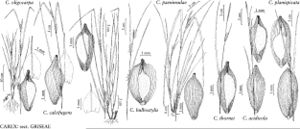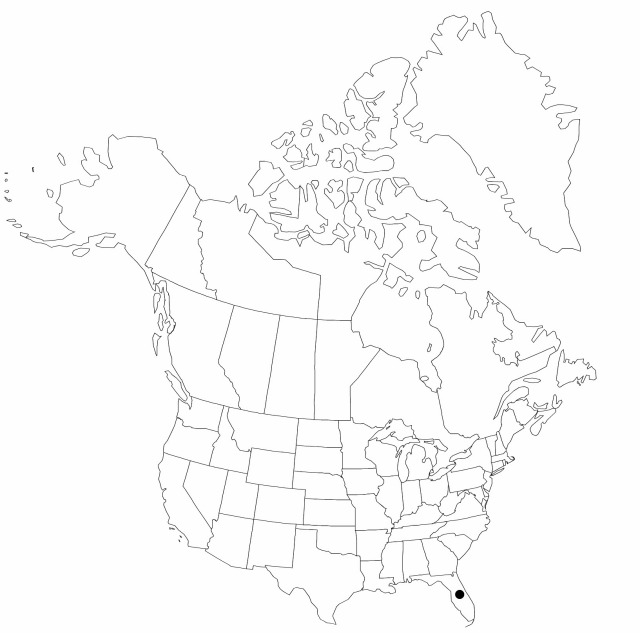Carex paeninsulae
Novon 12: 514, fig. 3. 2002.
Plants loosely cespitose; rhizome internodes 7–58 mm, 1.2–2.2 mm thick. Culms purple-red to 4.8–11.4 cm at base, 8.9–39 cm; vegetative shoots 33–59 cm, 1.4–2.2 times as tall as culms. Leaves: green, widest blades 3–4.6 mm wide. Inflorescences 8.1–29 cm, 0.73–0.95 of culm height; internode between proximalmost scales in proximalmost spike 2.4–3.5 mm; internode between distal lateral spikes 0.4–7.4(–9.8) cm, longest internode between distal lateral spikes 0.9–7.4(–9.8) cm; peduncle of terminal spike 0.3–3.2(–6.8) cm, longest peduncle per plant 0.87–3.2(–6.8) cm; proximal bract sheaths tight, hyaline band of adaxial face of sheath with apex truncate or concave; ligules 4–4.9(–9.6) mm; blades uniformly green, bract blade of distalmost lateral spike exceeding terminal spike, longest bract blade of distalmost lateral spike 3.2–9.5 cm. Spikes 4–6, distalmost 2–3 spikes overlapping or, rarely, all spikes separate; lateral spikes pistillate, with 2–12 perigynia, longest spike per plant with (5–)7–12, 7–20 × 3.5–4.8 mm, ratio of longest lateral spike length (in mm) to flower number = 1.8–2.5; terminal spike 14–38 × 1.2–2.1 mm, longest per plant 17–38 mm, exceeding distalmost lateral spike Pistillate scales 2.5–4.2 × 1.4–2.2 mm, body 1.5–2.4 mm, midrib prolonged as awn 0.4–2.4 mm. Staminate scales 3.9–4.8 × 1.2–1.8 mm, apex acute, awn 0–2.2 mm. Perigynia distichously imbricate, prominently 49–66-veined, slightly inflated, narrowly obovate in outline, obtusely trigonous in cross section, 4.1–4.7 × 1.4–1.6, 2.7–3.1 times as long as wide, 1.8–1.9 times as long as achene bodies, base gradually tapered, apex gradually tapered; beak absent or straight, 0–0.4 mm, 0–0.1 of perigynium length. Achenes 2.9–3.4 × 1.3–1.4 mm, tightly enveloped by perigynia, base abruptly contracted, apex abruptly contracted; stipe 0.5–0.6 mm; body 2.2–2.6 mm; beak straight, 0.1–0.3 mm.
Phenology: Fruiting spring.
Habitat: Mesic deciduous forests, in sandy loams
Elevation: 0–30 m
Discussion
Of conservation concern.
Carex paeninsulae is rare and restricted to the northern half of the Florida peninsula.
Selected References
None.

